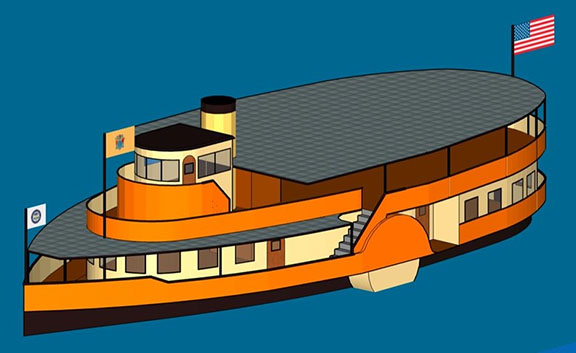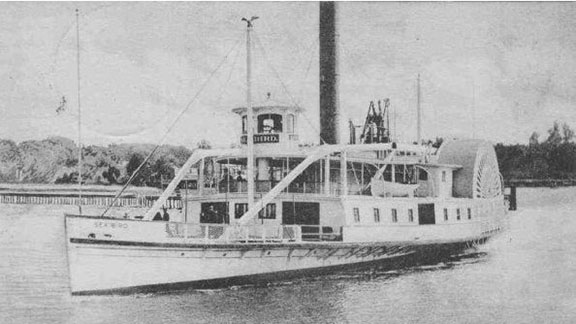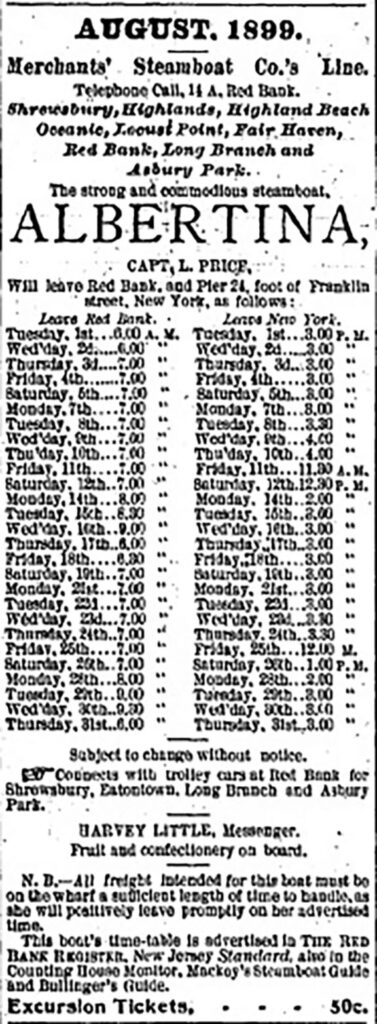
By JF Grodeska
It is difficult to imagine what the towns along the Shrewsbury and Navesink rivers were like in the days before the automobile. The mind creates images of horse-drawn wagons and carriages and people walking from town to town. But the reality is that paddlewheel steamships were the transportation of choice to move residents and cargo between riverine towns.
For more than 60 years in the latter half of the 19th century and into the 20th, as many as nine steamboat companies serviced most of the towns along the Shrewsbury River and provided service to New York City. Two of the most well-known vessels were the Albertina and Sea Bird. These ships belonged to the Merchants Steamboat Company which operated from Highlands and communities along the Shrewsbury River to New York between 1866 to 1926.
On Oct. 1, 1908, Henry Ford introduced his “Everyman’s Car,” the Model T. It was hand assembled at Ford’s Piquette Avenue plant in Detroit, Michigan. Hand assembly meant low production numbers. Only 11 cars were manufactured that first month. However, by 1927, when Ford discontinued the Model T, over 15 million cars had been produced. Ford’s mass production assembly line design could produce one Model T every 93 minutes.
Ford’s success and the widespread ownership of automobiles heralded the end of the river steamboat era.
Four years from now, in 2026, the United States will celebrate “America250” a multiyear effort to commemorate the semiquincentennial, or 250th anniversary, of the Declaration of Independence. The website america250.org describes the initiative: “This effort is being led at the national level by the non-partisan U.S. Semiquincentennial Commission, created by Congress, and its supporting nonprofit America250 Foundation, with a mission to catalyze a more perfect union by designing and leading the most comprehensive and inclusive celebration in our country’s history. America250 represents a coalition of public and private partners all working to create initiatives and programs that honor our first 250 years and inspire Americans to imagine our next 250. The commemoration period began in 2020, culminates on July 4, 2026, and officially concludes in 2027.”

New Jersey is developing a program called Revolution NJ (revolutionarynj.org) to explore the state’s role in America’s birth and history and how lessons learned can be applied to the future. “Acknowledging the questions people faced on the eve of the American Revolution remain pertinent today,” according to the website.
Rik van Hemmen, president and CEO of Martin & Ottaway, a marine consulting firm, and president of the Navesink Maritime Heritage Association, has a different project in mind for New Jersey’s contribution to America250. Van Hemmen wants to build a paddlewheel vessel to ply the waters of the Shrewsbury River once again. This boat wouldn’t be a replica of a steamboat, with diesel engines and a paddlewheel as a decoration, as seen on the river each summer, but a state-of-the-art, 21st century vessel: a solar powered paddlewheel.
A document provided by van Hemmen outlined the project. “Traditionally steamers of this type were built with round bilge hulls. These very fine hulls were needed to provide maximum speed with heavy power plants of limited power. Lower weight and more powerful propulsion equipment, and less pressing speed requirements, do not require the use of such a high-cost hull.”
His boat will have a hard chine (angled) hull below and a traditional shape above the waterline, made of composite materials and aluminum to reduce construction cost and make the boat easier to maintain.
A major difference between the steamboats of old and van Hemmen’s? There won’t be any steam. Steam plant propulsion is unrealistic – too costly and complex – and use of diesel fuel would send the wrong ecological message. Instead, the vessel will be primarily electric powered with solar batteries. A standby diesel generator will allow the vessel to traverse longer distances at a higher speed, when necessary.

“Since New Jersey is deeply committed to sustainable electricity, solar power battery charging will greatly enhance the vessel’s role as an environmental ambassador,” van Hemmen wrote.
Specifications for the “steamboat” show it will be 100 feet long with a battery capacity of 200kWh, enough to provide three hours of sailing at 6 knots. With the battery operation, the boat will be virtually silent when running.
In the lead up to America250, the vessel would be used to tour local communities with a traveling exhibit of subjects relating to America250 to raise awareness of the upcoming celebration. This would facilitate media coverage in the New York and New Jersey metro area with port visits and could ferry paid passengers to local points of historical interest and provide Revolutionary War educational cruises. The ship could serve as a symbol of Monmouth County at large America250 events.
The solar paddlewheel has many commercial applications. It is far less costly to operate and more durable than ordinary fossil fuel-dependent vessels. After the America250 celebration, the boat could run everything from sightseeing cruises, banquet cruises, dinner or music cruises.
The project is still in the planning stages. Van Hemmen estimates the initiative will cost approximately $4 million. A quarter of that would be required up front and would come from donations. The remaining $3 million would come from commercial lenders.
How does van Hemmen know his design will work? He has already built a solar-powered vessel. “My wife became wheelchair bound and I ended up building and designing a wheelchair accessible solar-powered catamaran named ‘Aberration,’ which is homeported in Red Bank,” van Hemmen said. “It has household solar power, electric outboard motors, batteries and a standby diesel generator. There’s an elevator for wheelchair access.”
Individuals interested in donating to or assisting with this project can contact van Hemmen at rhemmen@martinottaway.com.
The article originally appeared in the November 24 – 30, 2022 print edition of The Two River Times.














